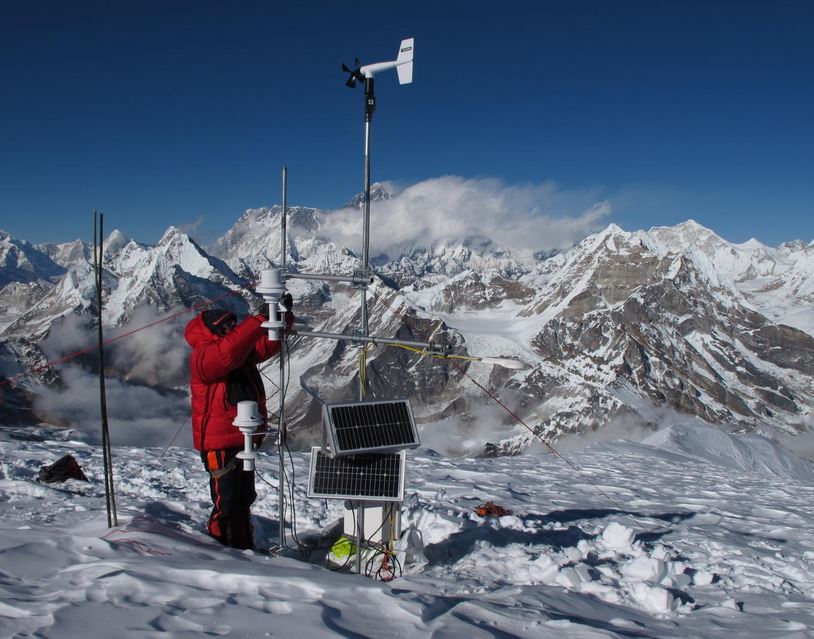Unless drastic action is taken now, most of the Everest glaciers will be gone by the end of this century, says a team of scientists from the Netherlands, Nepal and France. They estimate there will be a reduction in glacier volume of between 70% and 99% by the year 2100.
The dramatic changes to affect glaciers in the Everest region of the Himalayas is likely to start soon if greenhouse-gas emissions continue to increase, the scientists wrote in the open-access journal The Cryosphere.
Study leader, Joseph Shea, a glacier hydrologist at the International Centre for Integrated Mountain Development (ICIMOD) in Kathmandu, Nepal, and colleagues have found that the Everest glaciers are likely to be extremely sensitive to future warming.
 A scientist taking measurements in the Mera Glacier region of the Dudh Kosi basin. (Image: Eurekalert. Credit: Patrick Wagnon)
A scientist taking measurements in the Mera Glacier region of the Dudh Kosi basin. (Image: Eurekalert. Credit: Patrick Wagnon)
Glacier mass loss most likely
“The signal of future glacier change in the region is clear: continued and possibly accelerated mass loss from glaciers is likely given the projected increase in temperatures.”
The 70% to 99% estimate in glacier volume reduction by 2100 comes from a model used by Dr. Shea and colleagues. How much is lost depends on how much greenhouse-gas emissions continue to rise.
Dr. Shea said:
“Our results indicate that these glaciers may be highly sensitive to changes in temperature, and that increases in precipitation are not enough to offset the increased melt.”
Not only will higher temperatures accelerate the rates of snow and ice melt, but could also change precipitation from snow to rain at critical altitudes, where glaciers are concentrated.
Double whammy of warmth plus rain
The combined effect of higher temperatures and rain (instead of snow) will make the glaciers melt faster and lose volume.
High Mountain Asia, a region that includes the Himalayas, has the greatest volume of ice outside the polar regions.
The scientists studied glaciers in the Dudh Kosi basin in the Nepal Himalaya, which includes Mt. Everest as well as some other high mountain peaks. The study covered more than 400 square kilometres of glacier area.
Dr. Shea said:
“Apart from the significance of the region, glaciers in the Dudh Kosi basin contribute meltwater to the Kosi River, and glacier changes will affect river flows downstream.”
The availability of water can also be affected by alterations in glacier volume, with consequences for hydropower generation and agricultures.
While greater glacier melt initially raises water flows, ongoing retreat eventually leads to reduced meltwater from the glaciers during the warmer months, with the greatest impact for the local populations ahead of the monsoon, when water is scarce.
Reduced glacier volumes can also lead to more lakes, caused by dams created by glacial debris. These dams can be breached by earthquakes and avalanches, causing devastating floods with rivers flowing at 100 times their normal rates in the Kosi basin.
To determine how glaciers in the region would evolve in the future, the scientists began by using field observations and data from local weather stations to calibrate and test a model for glacier change over the last five decades.
Co-author, Walter Immerzeel, who works at Utrecht University in the Netherlands, said:
“To examine the sensitivity of modelled glaciers to future climate change, we then applied eight temperature and precipitation scenarios to the historical temperature and precipitation data and tracked how glacier areas and volumes responded.”
The glacier response is partly due to changes in the freezing level, the elevation where mean monthly temperatures are 0°C.
Dr. Immerzeel said:
“The freezing level currently varies between 3200 m in January and 5500 m in August. Based on historical temperature measurements and projected warming to the year 2100, this could increase by 800-1200m.”
“Such an increase would not only reduce snow accumulations over the glaciers, but would also expose over 90% of the current glacierized area to melt in the warmer months.”
Study just an initial approximation
However, the authors caution that their results should be viewed as a first estimate to how Himalayan glaciers will react to rising temperatures in the region.
Patrick Wagnon, a glaciologist at the Institut de Recherche pour le Développement in Grenoble, France, and a visiting scientist at ICIMOD, said:
“Our estimates need to be taken very cautiously, as considerable uncertainties remain.” For example, the model simplifies glacier movements, which impact how glaciers respond to increases in temperature and precipitation.”
Even under the most conservative climate change scenario, there will be glacier change in the region, the researchers warned.
Citation: “Modelling glacier change in the Everest region, Nepal Himalaya,” J. M. Shea, W. W. Immerzeel, P. Wagnon, C. Vincent, and S. Bajracharya. The Cryosphere. Published 27 May, 2015. DOI: 10.5194/tc-9-1105-2015.
